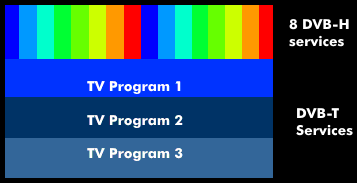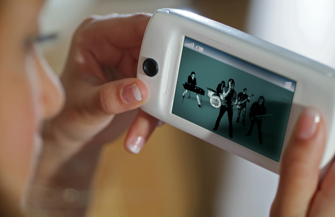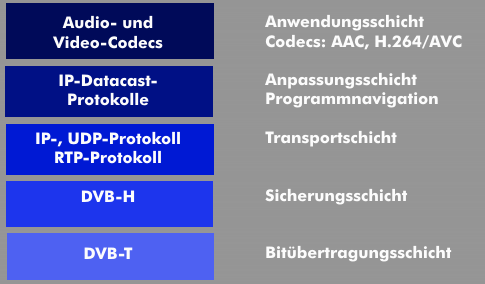DVB for handhelds (DVB-H)
DVB for Handhelds (DVB-H), digital television for mobile devices such as TV cell phones and smartphones, emerged from the DVB-X standard proposal for mobile terrestrial broadcasting. DVB-H and the further development DVB-H2 are television transmission standards for mobile TV, based on DVB-T, the terrestrially broadcast DigitalVideo Broadcast (DVB).
DVB-H was standardized in 2004. It uses the 8 MHz wide transmission channels of DVB-T in the UHF range and can transmit several television programs, data services and digital broadcasting via such a channel at a data rate of over 20 Mbit/s. Assuming a data rate of 384 kbit/s, DVB-H can transmit more than 20 TV programs per transmission channel. The various services are transmitted periodically in compressed bursts.
An important aspect of DVB-H is the energy consumption and thus the battery operating time of the mobile terminals. To keep this as low as possible, burst transmission is used to save energy. For this purpose, the RF receiver sections of the mobile terminals are switched on and off in time-division multiplex, and only when the burst signal of the corresponding TV station is received. This technique is called time slicing and helps to save a considerable amount of energy and thus prolong battery operation. In time slicing, the merging of the various services takes place in time multiplex. Incoming bursts are buffered so that the downstream decoder can read them at a constant bit rate.
DVB-H uses the IP protocol for data transmission. The underlying data rate is 384 kbit/s, which is perfectly adequate for good sound and video quality on a display with a picture resolution in quadruple VGA( QVGA) with 320 x 240 pixels or also in CIF display format with 360 x 288 pixels.
An important requirement for mobility is the power consumption of mobile devices such as portable media players, TV cell phones and handhelds, which must not exceed 100 mW. This requirement is met by time slicing. In addition, procedures for improving reception in poor reception conditions and forward error correction( FEC) are implemented in DVB-H terminals: Multiprotocol Encapsulation Forward Error Correction( MPE-FEC). These procedures ensure a significant improvement in reception with the quadrature amplitude modulation (16QAM) that is common in Germany. In addition, DVB-H relies on the very effective video compression H .264/ AVC; for audio transmission, DVB-H uses MPEG-4aacPlus. DVB-H has a platform that supports IP protocol, video and MPEG.
In DVB-H, the lower layers are defined with the physical layer and the link layer for access. The transport layer above supports the IP protocol, the UDP protocol and the Realtime Transport Protocol( RTP). Above this is the adaptation layer, for the IP datacast protocols. These include program navigation between services, support for interactive services, and program encryption. Since IP-Datacast also provides an additional mobile radio channel, DVB-H offers an upstream channel for interactive applications with this return channel.
In terms of transmission technology, DVB-H can operate in the frequency ranges between 470 MHz and 890 MHz for DVB-H, which is, however, occupied by DVB-T, in the L-band between 1.452 GHz and 1.492 GHz( EU) and between 1.670 GHz and 1.675 GHz (USA). DVB-H uses orthogonal frequency division multiplex( OFDM) (2k, 4k, 8k) and quadrature amplitude modulation (16QAM, 64QAM) as modulation methods.



